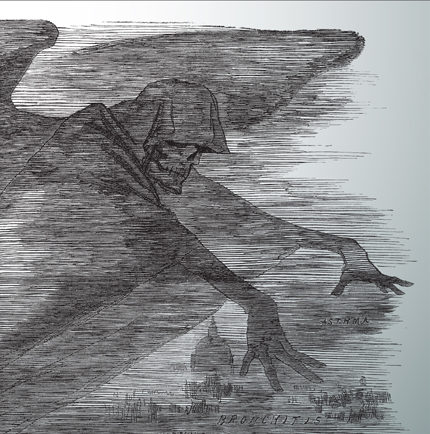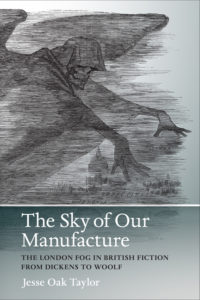
The Sky of Our Manufacture: The London Fog in British Fiction from Dickens to Woolf by Jesse Oak Taylor

This is part of our special feature Facing the Anthropocene.
A slew of recent books around the theme of “Victorian ecology” have located the origins of the Anthropocene in this period. The mooted new geological age (marked by humanity’s indelible alteration of the rock strata and atmosphere of the Earth) began, it’s been argued, with nineteenth-century industrialization. In Fossil Capital, Andreas Malm argues that contemporary globalization’s fossil economy was forged by capitalism’s development and utilization of steam power in the nineteenth century. Consequently, critics have turned to consider how Victorian responses to pollution, environmental damage, and perceived alterations in the atmosphere, weather, or climate could inform our deliberations about living in what Jason W. Moore calls the “world ecology” of “capitalism-in-nature,” where the permeation of an economic system into the earth, atmosphere, and other creatures extends to human being itself. This rich book – with chapters on Dickens, George Eliot, Robert Louis Stevenson, Bram Stoker, Conan Doyle, Conrad, and Woolf – is, then, topical, even more so given reports just this month about rising levels of toxicity in London’s air. Taylor considers, specifically, how literature could inform and shape our response to the grave paradox of the Anthropocene: that while humanity has become “a force of nature affecting planetary systems on nearly every level” that force is spiralling out of our control, possibly towards the extinction of humankind itself.
Taylor’s literary criticism is supported by a historical frame, geographical foundation, and thematic focus, the latter encompassing the sophisticated engagement with environmental science, which characterizes the best ecocriticism. Its time span runs, in one sense, from the Great Exhibition of 1851 to 1952’s “smog disaster.” Trapped air above London froze temperatures, imprisoning Londoners in a smoky fog that engendered wheezing, vomiting, and internal bleeding, and which killed more than four thousand people. The disaster forced decisive action on smog (which had enveloped London for one-hundred years) with the passing of the UK’s Clean Air Act in 1956. Yet while London offers the geographical setting for The Sky of Our Manufacture, this is no localized history. On the contrary, the book’s site-specificity is merely a means to address the dramatic temporal and spatial increases in scale engendered by the Anthropocene. On the one hand, at the epicentre of modernity, London’s smog disaster precipitated the start of a human confrontation with our own carbon-induced impact on the planet just as a “great acceleration” in that impact was starting. As Taylor puts it, the “London particular,” a colloquial name for the capital’s smog, would become, in global climate change, “Metropolis Earth.” On the other, Taylor recounts how the deep historical awareness, essential for perceiving how our all-conquering “fossil economy” is founded (literally) in the bedrock of “nature,” began to develop early in this period when it was realised that coal stored the solar energy of past aeons. The knowledge of scientists like T. H. Huxley diffused into common knowledge via (for example) children’s stories.
Taylor’s thematic focus is atmosphere and climate. More than once, he identifies the book’s “central theme” as “The combined problem of learning to see the smog and the discomfort produced by finding it beautiful” (so beautiful, indeed, that artists such as Monet and Yoshio Markino travelled to London to paint the fog). Yet this somewhat banal, aesthetic concern belies a more profound paradigm: that if climate, of all natural phenomena, is “furthest from human influence,” then the London smog epitomises an unprecedented entanglement of human historical, ideological, political and cultural systems with nature. The novel does not so much represent climate as exist as “an active constituent […] in the ideological formations and social practices responsible for filling the atmosphere with smoke.” At the same time, aesthetics can shift our perception. It can confront the fact that the environment, the atmosphere, our climate, carries the mark of human activity and it can aid us in re-imagining our place in the complex “web of life.”
Offering a three-part literary history of the Anthropocene, encompassing Victorian, fin de siècle, and modernist novels, these well-researched literary readings concoct a sophisticated story about the role of the novel in responding to a gradually developing sense of the Anthropocene. In the first section, Taylor examines Dickens’ Bleak House and Our Mutual Friend which rather than offering a “realist” depiction of London expose underlying, unexpected networks of “connexion.” Those networks operate through the prism of what Taylor calls the “abnatural,” in which nature is no longer separated from the human. Rather, it appears (disturbingly) as something “other” than itself in a world that no longer complies with conventional ideas of nature. By the fin de siècle, the fog that signifies environmental pollution has crossed human-nonhuman boundaries and gets given a face and a body in the cartoons of the “fog-demon” that abounded in this period. If it requires the insight of a Sherlock Holmes to even begin to decipher this “dark ecology” (in one passage Taylor compares Holmes reading signs buried in dirt to ice-core analysis), he ultimately concludes that Holmes can only effectively present this “malodorous” atmosphere via a “malodorous and disordered atmosphere of his own.”
The logic of this narrative is that to adequately represent this strange, polluted place would require modernist techniques of fragmentation and “irrealism.” As humanity gradually moved from the stability of the Holocene, where a settled climate laid the basis for agriculture and human civilisation, to the utter unpredictability of the Anthropocene, Taylor calls forth modernism as a form of impressionism (e.g. in the novels of Conrad) adapted so as to mediate and confront us with newly complex relations with space and time. Highly aestheticized representations, for example, of beautiful sunsets in a “smog-filled sky” dramatise and draw our attention to the impact of human society on the nonhuman environment; correspondingly, as “an abstraction that can only be apprehended in and through time” climate requires fragmentary techniques which can “refigure our relationship to deep time, making any moment at once immediate and radically dispersed on scales that exceed the human memory.” This Taylor demonstrates via Woolf’s Orlando and the residual, persistent afterlife of the dying city in Richard Jefferies’ (pre-modernist) After London.
Offering a clear, historical trajectory, The Sky of Our Manufacture feels less assured in its further-flung diversions. I was unconvinced, for example, by the attempt to ‘resuscitate’ the ecological significance of “metaphors whereby we speak of the ‘atmosphere’ of a novel […] and the climate from which a work is said to emerge;” or, in turn, by assumptions about the act of reading – where readers enter into the “atmosphere” of the novel and engage in “imaginative projection.” These seemed a little speculative. The latter is explored in a section entitled “Affect, Sensation, and the Physiology of the Novel.” Taylor grounds a reading of Eliot’s Daniel Deronda in both contemporary neurological sources and the fin de siècle writer Vernon Lee’s attempted correlation between literary form and its impact on “nerve tracks […] muscles, heartbeats and breathing.” This concentration on breath and the body seems odd, however, when that is surely the province of oral forms like poetry, theater, song, even comedy. And it seems at odds with the fact that the majority of the book appears to emphasize cognition not least in the closing lines where Taylor describes the act of tracing pollution and environmental impact through literature as the work of “deliberation” in the sphere of “the critic.”
Taylor is on much firmer ground when he sticks with narrative which, as he argues, “places objects or entities and events in sequence in order to understand the relationships between them.” Yet his diversions into “affect” are not irrelevant and in fact would have felt less speculative had they been more firmly rooted in the nineteenth-century. Notably, Taylor might have referred to Leo Spitzer’s famous account – in his 1942 essay, “Milieu and Ambiance: An Essay in Historical Semantics” – of how literary concepts of atmosphere and climate emerged from a nineteenth-century intellectual culture preoccupied with concepts of “environment” or “milieu.” Spitzer’s essay was cited recently in Timothy Morton’s The Ecological Thought. Taylor’s account of how Dickens, Stevenson, Conrad or Woolf didn’t just represent smog mimetically but concocted a literary atmosphere that recreated the disorienting experience of it (eventually influencing society to act) perfectly exemplifies how the ambient “ecomimesis” advocated by Morton had already emerged fully formed in Victorian literature. Consequently, Taylor’s argument that, dispersed across the years, texts take on a significance which cannot be seen in their own time, underestimates the concrete historicism of what he is describing.
All this highlights a slight lack of reading in the rapidly growing field of Victorian ecocriticism betrayed when Taylor refers to “the relative scarcity of explicitly eco-critical work” in Victorian studies. Key books are absent or near enough absent: Michael Wheeler’s Ruskin and Environment (1995); James Winter’s Secure from Rash Assault: Sustaining the Victorian Environment (1999); Mike Davis’ Late Victorian Holocausts (2001); while published essays suggest it simply isn’t true that the ‘ecological implications’ of Dickens’ vision “have not been sufficiently articulated.” That sounds like quibbling, but it is, rather, frustration that the more speculative diversions undercut a deeper, more substantive Victorian ecocriticism. We find that substance, for example, when Taylor traces a tangible connection between George’s Eliot’s interest in physical science, specifically diffusion and atmospheric dispersal, and ecological ethics via the closing lines of Middlemarch: “the growing good of the world is partly dependent on unhistoric acts.” Or vice versa. The London smog was caused (as Taylor highlights) not only by industry but by the public’s fondness for domestic coal fires. As Christine L. Corton, author of London Fog: The Biography, has suggested, this has its parallel today in “our love for cars and other means of private transport.” However small, all our actions – from recycling and cycling to writing, reading, and criticism – have a potential to be ecologically virtuous; or damaging. That, ultimately, is a worthwhile lesson to take from an comprehensive work of literary historical research.
Reviewed by John Parham, University of Worchester
The Sky of Our Manufacture: The London Fog in British Fiction from Dickens to Woolf
by Jesse Oak Taylor
Publisher: University of Virginia Press
Hardcover / 272 pages / 2016
ISBN: 9780813937922
To read more book reviews, please click here.
Published on May 2, 2017.
References:
Christine L. Corton, London Fog: The Biography (Cambridge, MA: The Belknap Press of Harvard University Press, 2015).
Mike Davis, Late Victorian Holocausts: El Niño Famines and the Making of the Third World (London and New York: Verso, 2001).
Andreas Malm, Fossil Capital: The Rise of Steam Power and the Roots of Global Warming (London and New York: Verso, 2016).
Jason W. Moore, Capitalism in the Web of Life: Ecology and the Accumulation of Capital (London and New York: Verso, 2015).
Timothy Morton, The Ecological Thought (Cambridge, MA and London: Harvard University Press, 2010).
Leo Spitzer, “Milieu and Ambiance: An Essay in Historical Semantics,” Philosophy and Phenomenological Research 3:2 (1942): 169-218.
Michael Wheeler (ed.), Ruskin and Environment (Manchester: Manchester University Press, 1995).
James Winter, Secure from Rash Assault: Sustaining the Victorian Environment (Berkeley and London: University of California Press, 1999).




